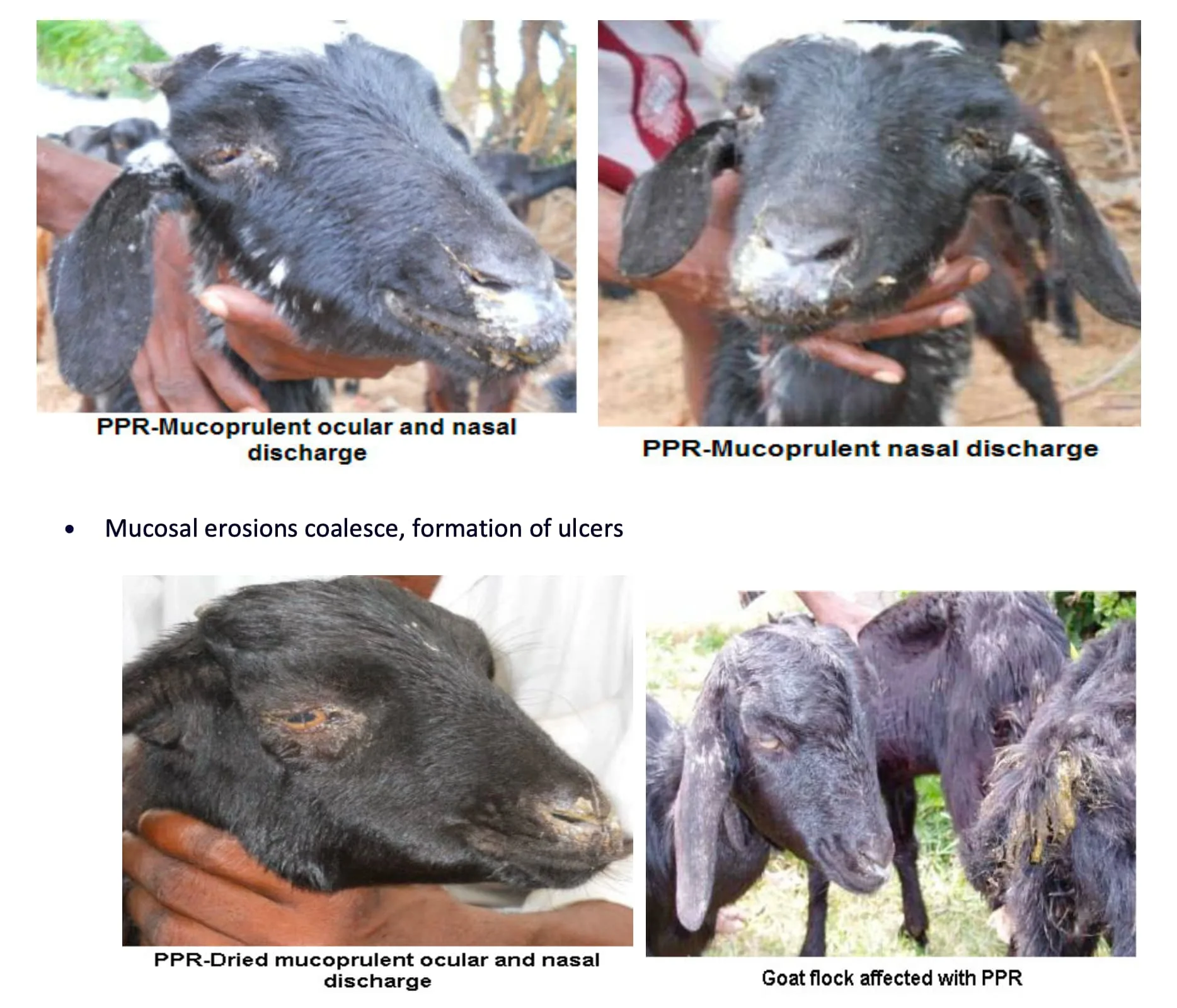Peste des Petits Ruminants (PPR)
Syn: Goat Plague, Pseudo rinderpest, Goat catarrhal fever
- It is acute or sub-acute highly contagious viral disease of sheep and goat.
- It is also known as pseudo rinderpest of small ruminants.
- It is characterized by fever, necrotic stomatitis, gastroenteritis and pneumonia.

Etiology
- Morbillivirus of Paramyxoviridae family
- Ss RNA, epitheliotrophic virus
- It has affinity to epithelial cells of GI tract, respiratory tract and lymphoid tissue.
Epidemiology
- Disease was first recorded in goat and sheep in Ivory Coast of West Africa in 1940
- Since then, disease has been recorded in enzootic manner in various countries like Senegal, Ghana, Nigeria, Sudan, Oman, Togo, Ethiopia, Saudi Arabia, Yemen, Benin, Mali, Jordan, Egypt, Israel, India, Pakistan, Bangladesh and Nepal.
- Disease is endemic in Nepal and first reported in 1995 and has spread across various ecological regions.
- Outbreaks tend to be more frequent in rainy season and autumn-late autumn, with less prevalence in summer.
- Disease has become endemic in 68 disease out of 77 districts of Nepal.
- Economic loss due to PPR accounts to approximately US $ 115.24 million per annum.
- First outbreak of PPR reported from southern districts of Nepal namely; Dhanusha, Mahottari, Bara, Sarlahi, and Rautahat in 1994 as an epidemic disease of goat. But, it was officially recognized only in 1995 after laboratory confirmation.
- Disease has got high morbidity ~100% followed by mortality of around 90% in young sheep and goat less than 6 months of age
Transmission:
- Disease transmits through close or direct contact with infected animals.
- Through contaminated food, water, harness, beddings
- Secretions and excretions of infected animals. Feces is main spreading agent
- No carrier state in animals like rinderpest
- Disease is not transmitted through insect vectors.
Pathogenesis:

Clinical Signs:
Incubation period of disease is 3-10 days.
Acute form:
- Sudden onset of fever; 104-106°F
- Depression, dullness, anorexia
- Rough body coat, dry muzzle, congested mucus membrane
- Serous nasal discharge, watery at early stage followed by mucopurulent catarrhal exudate later- crust over and occludes nostrils.
- Congested conjunctiva with profused catarrhal conjunctivitis
- Necrotic stomatitis with halitosis
- Discrete necrotic lesion in mouth- Diptheritic plaques (bran-like deposition)
- Profuse diarrhoea accompanied with dehydration, emaciation, hypothermia
- Respiratory distress and coughing
- Abortion in pregnant animal

Sub-acute form:
- More common in sheep
- Signs and lesion are less marked
- Most of animal recover and death occurs only in few.

PM Findings:
- Congested conjunctiva
- Necrotic lesion on lip, gum, nasal mucosa
- Necrotic and ulcerative lesion on buccal mucosa, pharynx and esophagus
- Erosion in abomasum
- Ulceration, hemorrhage in ileo-caecal valve
- Zebra marking in large intestine
- Congested larynx, trachea and bronchi
- Pneumonic changes in lungs
- Enlarged lymph nodes, splenomegaly

Diagnosis:
- Presumptive diagnosis is made based on clinical findings and PM findings
- Confirmatory diagnosis is made in laboratory by viral isolation and identification
- Antigen detection by ELISA or PCR
- Currently, antigen capture ELISA and reverse-transcription PCR assay are the preferred laboratory tests for confirmation of the virus
- Blood examination: Leucopenia, Hypokalemia, Hemoconcentration, hypoglycemia, uremia
- Serological test: CFT, AGPT, ELISA
- Competitive ELISA and virus neutralization are the tests recommended by the World Organisation for Animal Health (WOAH). The specimens required are lymph nodes, tonsils, spleen, and whole lung for antigen or nucleic acid detection, and serum for antibody detection
Differential diagnosis:
- Rinderpest:
- PPR causes pneumonia and course is rapid. Rinderpest, on other hand causes severe intestinal lesion.
- It primarily affects cattle.

- FMD:
- Lesion are usually confined to feet and mouth.
- Lameness is cardinal signs in FMD
- Diarrhoea is less severe than PPR
.jpg)
- CCPP:
- Lung lesion is more diffuse
- Coughing is prominent
- Straw colored fluid in thorax

- Blue Tongue (BT):
- Sheep is more affected than goat in BT
- Presence of head edema, cyanosis of tongue

- Orf:
- No diarrhoea and pneumonic changes

- Heartwater:
- It is tick borne disease caused by rickettsia
- Nervous signs: ataxia, circling, chewing movements, convulsions
- No diarrhoea or mouth erosions

- Coccidiosis:
- No mouth lesions
- Affects mostly kids/lambs
- Often bloody diarrhoea

Treatment and Control Measures:
- No specific treatment available. Symptomatic treatment for diarrhoea and respiratory distress is done
- OTC @ 10mg/kg, b.wt along with levamisole @ 2.5 mg/kg, b.wt. Same treatment repeated after 3 days
- Hyper immune serum @ 5-10 ml, S/C, SD
- Oral rehydration solution (ORS) with electrolytes; in severe dehydration Ringer’s lactate or Normal saline is administered IV
- Flunixin meglumine 2 mg/kg IV or Meloxicam 0.5 mg/kg SC to reduce fever.
- Gentle cleaning of mouth with mild antiseptic (1% potassium permanganate) or glycerine–borax mixture
- PPR deaths are often due to severe dehydration + secondary pneumonia. So, supportive care should target these two issues aggressively.
- soft, easily digestible feeds (green forage, gruels) should be offered.
- Molasses water can help increase energy intake.
- Isolation of sick animals to prevent spread of disease.
- Clean, dry, warm environment with minimal stress should be provided
- Disinfection of pens, troughs, and equipment (e.g., 4% NaOH, 2% phenol, 1% sodium hypochlorite).
- Restriction of movement of animals in and out of the premises.
- Dead carcass should be disposed of properly either by burying deeply or burning.
- Vaccination; Tissue culture vaccine @ 1ml, S/C, annually. First vaccination done at age of 3-4 months
- Quarantine of new stock for at least 21 days